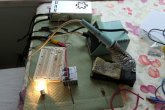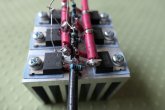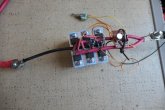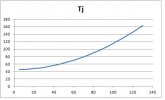Actually this DIY project is a high side switch, not SSR. The difference is that a SSR will have ground isolation between the "coil inputs" and the power output. In my case, I don't require isolation. This eliminates an optoisolator.
Im using 6 p-channel mosfets (STP80PF55) wired in parallel to lower the on resistance. The mosfet on resistance spec is 18 mOhm. 6 in parallel should get resistance down to 3 mOhm (in theory).
SwithcSetUp.jpg
Here's the test setup with 3 mosfets installed on the heatsink. The load is a 2A light. The switch voltage drop is 13 mV. On resistance is 13 mV / 2A = 6.5 mOhm
The mosfets are mounted on a 2x2" heatsink. M3 threads are taped into the heatsink to secure the fets. Due to the heatsink fins, there's no room for nut.
Switch1.jpg
6 mosfets mounted in place. Voltage drop is 7 mV at 2A load, resulting in 3.5 mOhm on resistance. That's pretty good. A small transistor driver board still needs to be mounted to the heatsink.
Switch2.jpg
Each mosfet has its own gate resistor. That decouples the mosfets from each other during switching. There isn't much switching going on so it doesn't matter much if there's switching interference. Switching speed isn't an issue.
I'll be doing some higher amps tests to see what this puppy can do. Heatsink temperature rise is the limiting factor for max current. A 20A load will generate 20^2 * 3.5 mOhm = 1.4 W. A 50A load will generate 9 W. That might be the limit (given the small heatsink size).


Im using 6 p-channel mosfets (STP80PF55) wired in parallel to lower the on resistance. The mosfet on resistance spec is 18 mOhm. 6 in parallel should get resistance down to 3 mOhm (in theory).
SwithcSetUp.jpg
Here's the test setup with 3 mosfets installed on the heatsink. The load is a 2A light. The switch voltage drop is 13 mV. On resistance is 13 mV / 2A = 6.5 mOhm
The mosfets are mounted on a 2x2" heatsink. M3 threads are taped into the heatsink to secure the fets. Due to the heatsink fins, there's no room for nut.
Switch1.jpg
6 mosfets mounted in place. Voltage drop is 7 mV at 2A load, resulting in 3.5 mOhm on resistance. That's pretty good. A small transistor driver board still needs to be mounted to the heatsink.
Switch2.jpg
Each mosfet has its own gate resistor. That decouples the mosfets from each other during switching. There isn't much switching going on so it doesn't matter much if there's switching interference. Switching speed isn't an issue.
I'll be doing some higher amps tests to see what this puppy can do. Heatsink temperature rise is the limiting factor for max current. A 20A load will generate 20^2 * 3.5 mOhm = 1.4 W. A 50A load will generate 9 W. That might be the limit (given the small heatsink size).







